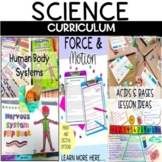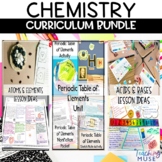Structure of the Atom Unit
- Zip
- Google Apps™

What educators are saying
Products in this Bundle (8)
showing 1-5 of 8 products
Bonus
Also included in
- Looking for a science curriculum to last all school year that will help you teach your physical science, life science, Earth science, and chemistry units? Check out everything this science curriculum has to offer. This year-long science curriculum includes science texts, hands-on activities, classroPrice $326.71Original Price $363.01Save $36.30
- Teach your students about chemistry using these materials that will allow students to read to learn about chemistry concepts and practice what they learned. This Chemistry Bundle includes states of matter, physical and chemical changes, atoms, elements, and the periodic table. This chemistry bundlePrice $100.60Original Price $125.75Save $25.15
Description
Teach students about atoms and elements using these print and digital activities. Students will learn about the parts of an atom ( proton, neutron, electron, and nucleus ) and elements through print, digital, and hands on activities. This atoms and elements unit includes activities to bring abstract topics to a concrete level. In addition, students will have the opportunity to practice what they learn through digital escape rooms, hands on creation of an atom, graphic organizers, review activities, and assessments.
Students will learn:
- What an atom is
- Parts of an atom
- Nucleus
- Protons
- Neutrons
- Electrons
- Atomic Number
- Atomic Mass
- Elements
This atoms and elements unit includes:
- Classroom decor posters to illustrate the different parts of an atom
- Protons
- Neutrons
- Electrons
- Nucleus
- Student reference sheet (five in color, five in black and white)
- My Atomic Life: A fun getting to know you project that incorporates the parts of the atom and relate them to aspects of a student's life
- Teacher presentation of important atomic structure concepts
- Student guided notes pages to follow along with teacher presentation
- A 15-page printable worksheet packet on
- What are atoms? Details their size, where they are found, and a very brief history,
- Atomic Theory - Students will dive deeper into how scientists (Democritus, Dalton, Thomson, Rutherford, Bohr, and others) studied and developed a visual model.
- Parts of the Atom - Students will learn about the different parts and their respective charges.
- Where are electrons? - Students will read how they are arranged around the nucleus.
- Atomic number - Explains what it is, how to find it, and why it is essential.
- Atomic mass - Summarizes what it is and how to determine the atom's mass.
- A digital (distributed through your learning management system; such as Google Drive, Schoology, or Microsoft OneNote) version of the above packet
- A hands-on activity. Students will create their atoms while answering questions about what they learned.
- Review color code activity: Included with three versions - atoms, Halloween, and Winter - all with print and digital options
- Digital and printable review activity
- Digital escape room
- An assessment (included as a bonus file)
- Atomic Number FREEBIE
- Answer key
How to use this atoms and elements unit in your classroom:
Classroom posters: Hang these posters around your classroom so that students can reference them throughout the unit. Posters include important vocabulary terms for students to know and understand.
Teacher presentation and Guided Notes: Introduce the unit to your students to Atomic Structure while they take guided notes. This activity allows for a classroom discussion and students will walk away with notes to use for reference throughout the unit.
Science texts: These reading packets can introduce or review the concepts with your students. They contain important concepts written out in an easy to understand manner. Students complete check in questions to assess their learning throughout the reading.
Hands on activity: Allows students to bring an abstract topic to life. By creating an atom, students can better understand its parts and their role in the atom.
Review activities: Graphic organizers, color code activities, escape rooms will allow students to understand the parts of an atom, atomic number, and atomic mass.
Assessment: Assess student understanding of the topic using the test or any formative review activities.
Check out the activities and lesson below to see precisely what is included:
- Classroom Decor Vocabulary Posters
- Getting to Know You Activity
- Atomic Structure Lesson
- Hands on Atom Activity
- Color Code Reviews
- Digital and Printable Activity
- Digital Escape Room
- FREEBIE
Feedback from teachers:
- This unit helped me a lot while teaching atoms. The students loved it and really understood what I was teaching. Thank you!
- A thorough resource I will use again as a review before state testing
- This resource was well done but turned out to be more than my 5th-grade curriculum called for. It is full of interesting facts and activities.
- A concise, kid-friendly, content-based unit of material that I used to review the concepts taught from our textbook. It could be used as a non-fiction reading comprehension activity or teach the concepts.
- This unit helped me get through my first year of teaching atoms and elements! My grade seven students enjoyed all the activities. Thank you very much!
- This packet was a fantastic resource to use in the classroom. The information was organized to where my 7th graders learned a lot and were engaged the entire time.
- This unit is excellent for my special education students. The information is easy to read, and the activities are challenging. Thank you for sharing
- Excellent resource. I love the variety of questions, and the periodic table hunt is great. I can't wait to try the editable atoms.
Kindly Note: If you have questions, do not hesitate in emailing me at Teaching Muse's Email
PLEASE PREVIEW BEFORE PURCHASING
____________________________________________________________________________________
Thank you for visiting Teaching Muse. I would love for you to become a follower.
Teaching Muse followers receive new product information and discounts on any new items!
____________________________________________________________________________________
All rights reserved by Teaching Muse. This product is to be used by the original downloader ONLY. Copying for more than one teacher, classroom, department, school, or school system is prohibited. Additionally, this product may not be distributed or displayed digitally for public view. Failure to comply is a copyright infringement and violates the Digital Millennium Copyright Act (DMCA). They are intended for classroom and personal use ONLY.







